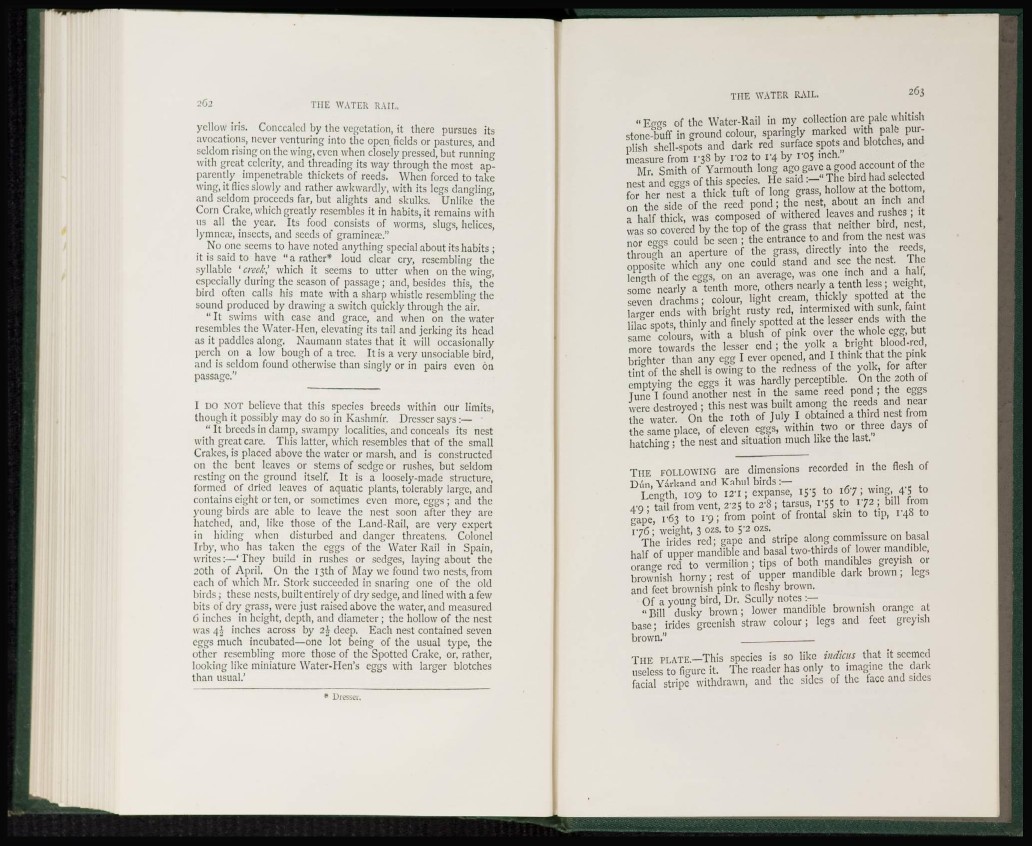
262 THE WATER RAIL,
yellow Iris. Concealed by the vegetation, it there pursues its
avocations, never venturing into the open fields or pastures, and
seldom rising on the wing, even when closely pressed, but running
with great celerity, and threading its way through the most apparently
impenetrable thickets of reeds. When forced to take
wing, it flics slowly and rather awkwardly, with its legs dangling,
and seldom proceeds far, but alights and skulks. Unlike the
Corn Crake, which greatly resembles it in habits, it remains wilh
us all the year. Its food consists of worms, slugs, helices,
lymnca.', insects, and seeds of graminere."
No one seems to have noted anything special about its habits ;
it is said to have " a rather* loud clear cry, resembling the
syllable 'creek', which it seems to utter when on the wing,
especially during the season of passage ; and, besides this, the
bird often calls his mate with a sharp whistle resembling the
sound produced by drawing a switch quickly through the air.
" It swims with ease and grace, and when on the water
resembles the Water-Hen, elevating its tail and jerking its head
as it paddles along. Naumann states that it will occasionally
perch on a low bough of a tree. It is a very unsociable bird,
and is seldom found otherwise than singly or in pairs even on
passage."
I DO NOT believe that this species breeds within our limits,
though it possibly may do so in Kashmir. Dresser says :—
" It breeds in damp, swampy localities, and conceals its nest
with great care This latter, which resembles that of the small
Crakes, is placed above the water or marsh, and is constructed
on the bent leaves or stems of sedge or rushes, but seldom
resting on the ground itself. It is a loosely-made structure,
formed of dried leaves of aquatic plants, tolerably large, and
contains eight or ten, or sometimes even more, eggs ; and the
young birds are able to leave the nest soon after they are
hatched, and, like those of the Land-Rail, arc very expert
in hiding when disturbed and danger threatens. Colonel
Irby, who has taken the eggs of the Water Rail in Spain,
writes:—' They build in rushes or sedges, laying about the
20th of April. On the 13th of May we found two nests, from
each of which Mr. Stork succeeded in snaring one of the old
birds; these nests, built entirely of dry sedge, and lined with a few
bits of dry grass, were just raised above the water, and measured
6 inches in height, depth, and diameter ; the hollow of the nest
was 4?, inches across by 2} deep. Each nest contained seven
eggs much incubated—one lot being of the usual type, the
other resembling more those of the Spotted Crake, or, rather,
looking like miniature Water-Hen's eggs with larger blotches
than usual.'
* DRESSER,
THE WATER RAIL, 263
" Eggs of the Water-Rail in my collection are pale whitish
stone-buff in ground colour, sparingly marked with pale purplish
shell-spots and dark red surface spots and blotches, and
measure from 138 by i' 02 to 1 4 by ro5 inch."
Mr. Smith of Yarmouth long ago gave a good account of the
nest and eggs of this species. He said :—" The bird had selected
for her nest a thick tuft of long grass, hollow at the bottom,
on the side of the reed pond ; the nest, about an inch and
a half thick, was composed of withered leaves and rushes ; it
was so covered by the top of the grass that neither bird, nest,
nor eggs could be seen ; the entrance to and from the nest was
through an aperture of the grass, directly into the reeds,
opposite which any one could stand and see the nest. The
length of the eggs, on an average, was one inch and a half,
some nearly a tenth more, others nearly a tenth less; weight,
seven drachms; colour, light cream, thickly spotted at the
larger ends with bright rusty red, intermixed with sunk, faint
lilac spots, thinly and finely spotted at the lesser ends with the
same colours, with a blush of pink over the whole egg, but
more towards the lesser end ; the yolk a bright blood-red,
brighter than any egg I ever opened, and I think that the pink
tint of the shell is owing to the redness of the yolk, for after
emptying the eggs it was hardly perceptible. On the 20th of
June I found another nest in the same reed pond ; the eggs
were destroyed ; this nest was built among the reeds and near
the water. On the 10th of July I obtained a third nest from
the same place, of eleven eggs, within two or three days of
hatching; the nest and situation much like the last."
THE FOLLOWING are dimensions recorded in the flesh of
Dun, Yarkand and Kabul birds :—
Length, 109 to 121 ; expanse, 1 S"5 to 167; wing, 4'5 to
4'9 ; tail from vent, 225 to 2'8 ; tarsus, 1-55 to 172 ; bill from
gape, 163 to i'9; from point of frontal skin to tip, 148 to
176; weight, 3 ozs. to 5'2 ozs.
The irides red; gape and stripe along commissure on basal
half of upper mandible and basal two-thirds of lower mandible,
orange red to vermilion ; tips of both mandibles greyish or
brownish horny; rest of upper mandible dark brown ; legs
and feet brownish pink to fleshy brown.
Of a young bird, Dr. Scully notes :—
"Bill dusky brown; lower mandible brownish orange at
base; irides greenish straw colour; legs and feet greyish
brown."
THE PLATE—This species is so like indicus that it seemed
useless to figure it. The reader has only to imagine the dark
facial stripe withdrawn, and the sides of the face and sides